World Air Transport Statistics


ICAO / Economic Development of Air Transport / Statistics. Safety and C — Environmental Protection and Sustainable Development of Air Transport.
This statistic represents the annual growth in global air traffic passenger demand between 2005 and 2018. In 2017, global air traffic passenger demand increased by 7.5 percent on the year before. By 2018, traffic is rpojected to grow with another six percent.
Annual growth in global air traffic passenger demand On a global scale, passenger air travel is expected to maintain positive growth rates up to 2030, despite a number of challenges faced by the industry: Airlines around the world are struggling with high jet fuel prices and sluggish However, these difficult economic conditions are predicted to be offset by an increase in passenger figures, which in turn is projected to translate into improved financial performance of the airline sector. It is believed that the global aviation industry will reach up to 38.4 billion US dollars in in 2018, up from only 8.3 billion US dollars in 2011. Between 2017 and 2036, the number of airline passengers is expected to grow at a (CAGR) of 4.7 percent. Low-cost carriers and regional airlines have revolutionized the airline business with the introduction of innovative low-fare business models.
Notwithstanding the fact that airlines such as and Ryanair have steadily eaten into the market share of major transportation companies. American Airlines remained the leading airline in terms of flown in 2016, followed by Georgia-based Delta Air Lines, United/Continental and Emirates Airlines. Aviation demand is set to be fuelled by the rising affluence of the middle classes in emerging markets. Quicktime Alternative For Vista more.
Consequently, the air traffic industry is forecast to most significantly in Latin America and Africa. In 2016, the airports in Atlanta (IATA: ATL), Beijing (IATA: PEK) and (IATA: DXB) were ranked as the three for passenger traffic. HTML code to embed chart as PNG Find more statistics at Statista. This statistic represents the annual growth in global air traffic passenger demand between 2005 and 2018. In 2017, global air traffic passenger demand increased by 7.5 percent on the year before. By 2018, traffic is rpojected to grow with another six percent. Annual growth in global air traffic passenger demand On a global scale, passenger air travel is expected to maintain positive growth rates up to 2030, despite a number of challenges faced by the industry: Airlines around the world are struggling with high jet fuel prices and sluggish However, these difficult economic conditions are predicted to be offset by an increase in passenger figures, which in turn is projected to translate into improved financial performance of the airline sector.



